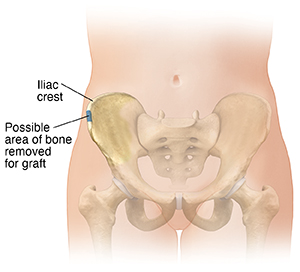Spinal Fusion: Understanding Bone Graft
To fuse the spine, very small pieces of extra bone are needed. These are called bone grafts. These bones act as the “cement” that fuses the vertebrae together. The fusion eliminates motion between the two fused vertebrae with a slight loss in flexibility. This surgery can help treat many different back conditions. Two of the more common types are grafts from a bone bank or from your own body. Your surgeon will choose the type of graft that’s best for you.
From a bone bank (allografts)
-
Bone banks collect, evaluate, and store bone. Allograft bone grafts are from either human donors who have had bone removed during surgery or from cadavers.
-
Often, the minerals and cells are washed out from the donor bone, leaving a demineralized bone matrix (DBM), which is used as a scaffold for new bone to grow. This process may stimulate bone healing.
-
Some allografts are mixed with bone-forming cells such as stem cells. These bone-forming cells come from younger donors, typically younger than 40 years old.
-
Donors are checked for their cause of death and health history. Tests are done to check for viruses such as HIV and hepatitis. The risk of getting a disease from a bone graft is extremely low. Harvested bone tissue is processed to decrease the risk of an immune response.
-
An advantage of allograft bones is they come in different shapes and sizes, so they're able to fit into the required area of the spine. Allograft also does a good job of getting bones to heal with a very low risk of it transmitting a disease.
From your own body (autografts)
-
A small amount of bone is usually taken from a part of your pelvic bone called the iliac crest, or from your vertebrae, or from a rib.
-
The bone is removed during the fusion surgery—a separate surgery isn't needed. Bone may be taken through the cut (incision) made for your fusion, or through a separate incision. The area the bone is taken from can hurt quite a bit until it heals, sometimes weeks or months later.
-
Apart from grafts from a bone bank or your own body, there are also artificial bone graft materials known as synthetic bone substitutes that can be used. Synthetic grafts do not have any cells, so they have to be mixed with other bone products to produce results. Your surgeon will determine what the best option is for you.
-
Bone morphogenetic protein (BMP) is a protein in your body that helps bone grow and heal. Where it's safe, it may also be used together with one of the choices above.
-
One of the advantages of autografts is that they contain cells, proteins, and scaffolding to promote bone healing without the risk of rejection.

© 2000-2024 The StayWell Company, LLC. All rights reserved. This information is not intended as a substitute for professional medical care. Always follow your healthcare professional's instructions.